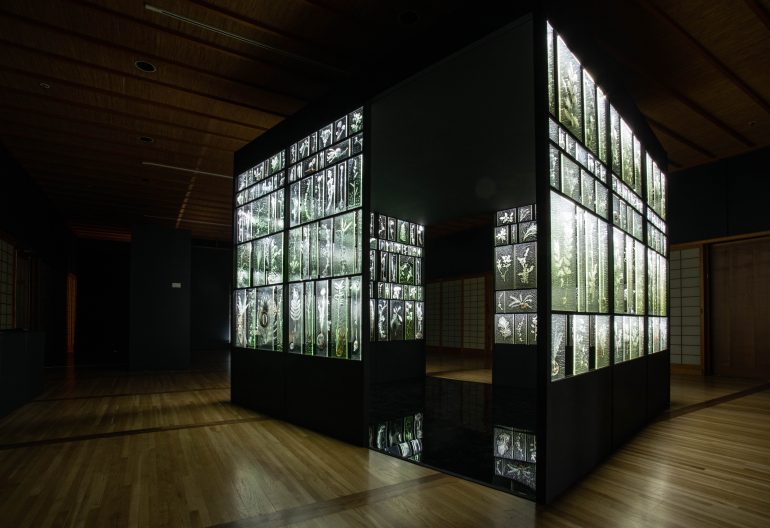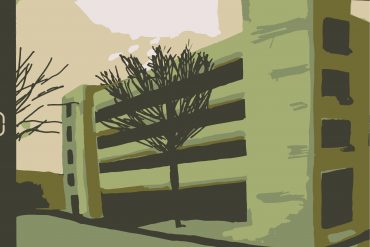In its sixtieth year, The Portland Japanese Garden is, as it ever has been, a portal. It’s both a garden and a teleportation device. When you walk through the gate over the path that leads to the entrance, you feel as though you’ve somehow stepped across the Pacific Ocean and into another country. In keeping with this transcontinental oeuvre, the Japanese Garden showcases rotating exhibits in its art pavilion, most often by Japanese or Japanese-American artists. This season’s artist, Rui Sasaki, primarily works in one medium: glass. Pressed into plates, in kilns as hot as 1400 degrees Celsius, the pieces are striking. The largest example of her work, a cube which dominates the pavilion’s darkened exhibition space, a room within a room, is titled “Subtle Intimacy: Here and There.” Dozens of glass plates sit in rows, illuminated from within, light refracting off the bright white remnants of the plants which have been suspended in the center of each hard, clear quadrilateral and turned to ash in the kiln. The ghosts of plants.
Half of these artworks, which are unlabeled to remove the initial sense of sterile botanical diagramming, use botanicals sourced from Sasaki’s native Japan. The other half, clearly separated by a space on the shelves and the empty air of the room-within-a-room’s door frame, are gathered from the Japanese Garden itself, collected over the last 6 months during the course of her two artist’s residences. A collaborative piece between not just Sasaki and the garden, or Japan and America, but between Sasaki, the gardeners of the PJG (specific individuals are mentioned in the accompanying plaques next to each piece) and Bullseye Glass Company, of southeast Portland.
Leaving behind the shadows of the pavilion and turning up the path from the koi pond, a glimmering curtain seems to hang in the air. 1500 ten-foot lengths of flexible glass that sway in the breeze like clouds and glint with dew misalign with their surroundings and disrupt the mossy, primordial garden. This is “Amayadori,” which translates to “taking shelter from rain.” In the tea house up the winding gravel path, a glass mold of a corner of Sasaki’s home in Kanazawa sits, unnerving in its immutability. Titled “The Corner,” it rests on a tatami mat and seems to be a fragment of another dimension, fallen through a tear in the fabric of reality. The sunlight cuts through the clouds and cascades through the overstory of the surrounding pine trees, brilliantly illuminating a patch of ground chosen by the ineffable whim of chance, before the spotlight shuts off as fast as if it were never there.
Much of Sasaki’s work deals with themes of weather and place. Raised in Japan, she attended Rhode Island School of Design and graduated in 2010 with an MFA. Before returning to her home country, she taught glass and contemporary art at her alma mater and throughout the United States, as well as at Kyoto University of Art and Design and Seto Glass and Ceramic Centre. The idea to preserve plants in glass plates came to her when she wanted to transport plants between the United States and Japan, a practice that is illegal due to invasive species laws. She wanted to create “portable memories.”

The plates sit for nineteen hours in the kiln, a process viewable in time-lapse form in an installation called “Inside the Kiln.” Despite the slow forging, the finished products contain bubbles, both large and small, imperfections which are left in their blemished state. When illuminated from below (as most of the exhibition pieces are) these flaws resemble raindrops frozen in time. Nature and weather preserved in its most authentic, petrified form. Life and body preserved in ash and death, beautiful to look at and intensely detailed.
Intentionality defines these pieces as it defines the garden. Before entering the art pavilion from the path outside, visitors may catch a glimpse of something glistening within its walls through the open doors. A mystery waiting to be solved, a sightline revealed on purpose by the garden’s curators. Every angle in the garden is perfected, every view a pleasing one to the eye. According to Will Lerner, the Communications Director for the garden and forbearant guide of my expedition, when their lead curator was once asked what made the Portland Japanese Garden stand out, he answered in one word: “maintenance.” Not just maintenance of the garden itself, but maintenance of values, maintenance of philosophy. Just as the cadaverous plants in “Subtle Intimacy” are unlabeled, so are the living plants of the surrounding garden. The experience is one not only of scientific interest, but one of the untranslatable experience of the place itself. This ethos is echoed in the work of Rui Sasaki.
More than once on the tour, Lerner and I stopped to admire the beauty of our surroundings. The Portland Japanese Garden has often been hailed as the best of its kind outside of Japan by visiting dignitaries. When asked how long he had been working there, he said, “A little over a year and a half. Every day I see something new.” A new viewpoint, a new perspective on the garden. A new experience. “It’s a special place,” he said.





